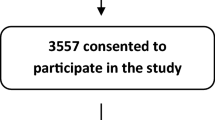Abstract
Background: This study investigates the relationship between religion and alcohol use, sedentary life style, and tobacco use. A survey of 990 noninstitutionalized persons 62 years of age and older was completed. Five life-style questions, three religious questions, and patient demographic information were studied. Results and conclusions were clear. Persons who are married, above the poverty level, non-white, and male are more likely to use alcohol. Subjects with sedentary life styles are more likely to be older, single, non-white, and female. Smokers are more likely to be below the poverty line and non-white. Finally, the relationship between religion and health risks seems minimal, possibly because of a selection bias.
Similar content being viewed by others
References
Koenig, H., Kvale, J. and Ferrel, C. (1988), “Religion and Well-being in Life.”The Gerontologist, pp. 18–28.
Ellison, C. (1991).The Journal of Health and Social Behavior. Vol. 32, No. 1, pp. 80–100.
Anson, O., Carmel, S., Bonneh, D., Levenson, A., and Maoz, B. (1990), “Recent Life Events, Religiosity, and Health: An Individual or Collective Effect”.Human Relations. Vol. 43, No. 11, pp. 1051–1067.
Comstock, G., and Partridge, K. (1972), “Church Attendance and Health”.Journal of Chronic Disability. Vol. 25, pp. 665–672.
Schmidt, W., and Popham, R. (1976), “Impressions of Jewish Alcoholics”.Journal of Studies on Alcohol. Vol. 37, No. 7, pp. 931–939.
Khavari, K., & Harmon, T. (1982), “The Relationship between the Degree of Professed Religious Belief and Use of Drugs”.The International Journal of the Addictions. Vol. 17, No. 5, pp. 847–857.
DeFonzo, J. and Pawlak, R. (1993). “How Gender Determines the Causes of Smoking: A Preliminary Report”.Psychological Reports. Vol. 72, No. 3, p. 1058.
Hay, Dr. and Foster, F. (1981), “The Influence of Race Religion, Occupation and Other Social Factors on Cigarette Smoking in New Zealand”.Internal Journal of Epidemiology. Vol. 10, No. 1, pp. 41–43.
Rose, C. and Cohen, M. (1988), “Relative Importance of Physical Activity for Longevity”.Annals New York Academy of Sciences, pp. 671–701.
Author information
Authors and Affiliations
Rights and permissions
About this article
Cite this article
Thorne, C., Nickerson, D. & Gemmel, D. The relationship between religiosity and health-risk factors in geriatrics. J Relig Health 35, 149–158 (1996). https://doi.org/10.1007/BF02354524
Issue Date:
DOI: https://doi.org/10.1007/BF02354524




